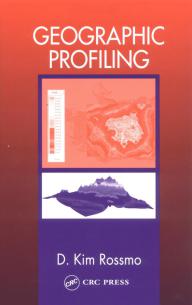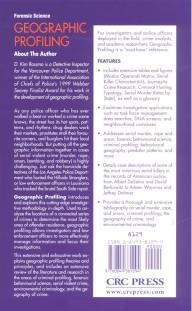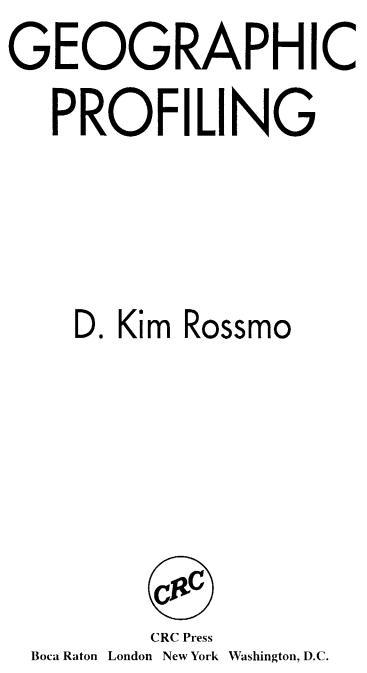
- •Foreword
- •Criminology Comes of Age
- •Rules That Commute
- •Environmental Criminology and the Path to Crime Control
- •Preface
- •The Author
- •Acknowledgments
- •Dedication
- •Table of Contents
- •List of Tables
- •List of Figures
- •Quotation
- •2.1 Serial Murder
- •2.1.1.1 Characteristics
- •2.1.2 Incidence, Population, and Growth
- •2.1.3 Theories
- •2.1.4 Victimology
- •2.2 Child Murder
- •2.3 Murder and Distance
- •3.1 Serial Rape
- •3.2 Serial Arson
- •4.2 Police Strategies
- •4.2.1 Linkage Analysis
- •4.2.1.1 Physical Evidence
- •4.2.1.2 Offender Description
- •4.2.1.3 Crime Scene Behaviour
- •4.2.2 Other Investigative Tactics
- •5.2 Organized and Disorganized Crime Scenes
- •5.4 Critiques
- •5.5 Evaluation Studies
- •5.7 Expert Testimony
- •6.1 Movement and Distance
- •6.2 Mental Maps
- •6.3 Awareness and Activity Spaces
- •6.3.1 Anchor Points
- •6.4 Centrography
- •6.5 Nearest Neighbour Analysis
- •7.1 Geography and Crime Studies
- •7.2 Environmental Criminology
- •7.2.1 Routine Activity Theory
- •7.2.2 Rational Choice Theory
- •7.2.3 Crime Pattern Theory
- •8.1 Target Patterns
- •8.1.1 Place and Space
- •8.1.2 Hunting Grounds
- •8.1.3 Target Backcloth
- •8.1.4 Crime Sites
- •8.1.5 Body Disposal
- •8.1.6 Learning and Displacement
- •8.1.7 Offender Type
- •8.2 Hunting Methods
- •8.2.1 Target Cues
- •8.2.2 Hunting Humans
- •8.2.3 Search and Attack
- •8.2.4 Predator Hunting Typology
- •9.1 Spatial Typologies
- •9.2 Geography of Serial Murder
- •9.2.1 Methodology
- •9.2.1.1 Serial Killer Data
- •9.2.1.2 Newspaper Sources
- •9.2.1.3 Offender, Victim, and Location Data
- •9.2.2 Serial Killer Characteristics
- •9.2.2.1 State Comparisons
- •9.2.3 Case Descriptions
- •9.2.3.1 Richard Chase
- •9.2.3.2 Albert DeSalvo
- •9.2.3.3 Clifford Olson
- •9.2.3.4 Angelo Buono and Kenneth Bianchi
- •9.2.3.5 Peter Sutcliffe
- •9.2.3.6 Richard Ramirez
- •9.2.3.7 David Berkowitz
- •9.2.3.8 Jeffrey Dahmer
- •9.2.3.9 Joel Rifkin
- •9.2.3.10 John Collins
- •9.2.3.11 Aileen Wuornos
- •9.2.3.12 Ian Brady and Myra Hindley
- •9.2.3.13 Jerry Brudos
- •9.4 Serial Murder Characteristics
- •9.4.1 Offenders
- •9.4.2 Victims
- •9.4.3 Locations
- •9.4.4 Crime Parsing
- •9.4.5 Clusters
- •9.4.6 Trip Distance Increase
- •10.1 Mapping and Crime Analysis
- •10.2 Geography and Crime Investigation
- •10.3 Offender Residence Prediction
- •10.3.1 Criminal Geographic Targeting
- •10.3.2 Performance
- •10.3.3 Validity, Reliability, and Utility
- •10.3.3.1 Validity
- •10.3.3.2 Reliability
- •10.3.3.3 Utility
- •10.4.2 Operational Procedures
- •10.4.2.1 Information Requirements
- •10.4.3 Understudy Training Program
- •10.4.4 The Rigel Computer System
- •11.1 Strategies and Tactics
- •11.1.1 Suspect Prioritization
- •11.1.2 Police Information Systems
- •11.1.3 Task Force Management
- •11.1.4 Sex Offender Registries
- •11.1.5 Government and Business Databases
- •11.1.6 Motor Vehicle Registrations
- •11.1.7 Patrol Saturation and Stakeouts
- •11.1.8 Response Plans
- •11.1.9 Mail Outs
- •11.1.10 Neighbourhood Canvasses
- •11.1.11 News Media
- •11.1.12 Bloodings
- •11.1.13 Peak-of-Tension Polygraphy
- •11.1.14 Fugitive Location
- •11.1.15 Missing Bodies
- •11.1.16 Trial Court Expert Evidence
- •11.2 Jack the Ripper
- •DATA CODING FORM #1: SERIAL MURDER OFFENDERS
- •DATA CODING FORM #2: SERIAL MURDER VICTIMS
- •DATA CODING FORM #3: SERIAL MURDER LOCATIONS
- •Glossary
- •Bibliography




© 2000 by CRC Press LLC

Library of Congress Cataloging-in-Publication Data
Rossmo, D. Kim
Geographic profiling/ D. Kim Rossmo p. cm.
Includes bibliographical references and index. ISBN 0-8493-8129-0
1. Criminal psychology. 2. Environmental psychology. 3. Criminal behavior, Prediction of. 4. Behavioral assessment. 5. Applied human geography. 6. Crime analysis. I. Title.
HV6080.R575 1999 364.3--dc21
99-051414 CIP
This book contains information obtained from authentic and highly regarded sources. Reprinted material is quoted with permission, and sources are indicated. A wide variety of references are listed. Reasonable efforts have been made to publish reliable data and information, but the author and the publisher cannot assume responsibility for the validity of all materials or for the consequences of their use
Neither this book nor any part may be reproduced or transmitted in any form or by any means, electronic or mechanical, including photocopying, microfilming, and recording, or by any information storage or retrieval system, without prior permission in writing from the publisher.
The consent of CRC Press LLC does not extend to copying for general distribution, for promotion, for creating new works, or for resale. Specific permission must be obtained in writing from CRC Press LLC for such copying.
Direct all inquiries to CRC Press LLC, 2000 Corporate Blvd., N.W., Boca Raton, Florida 33431.
Trademark Notice: Product or corporate names may be trademarks or registered trademarks, and are only used for identification and explanation, without intent to infringe.
© 2000 by CRC Press LLC
No claim to original U.S. Government works
International Standard Book Number 0-8493-8129-0
Library of Congress Card Number 99-051414
Printed in the United States of America 1 2 3 4 5 6 7 8 9 0
Printed on acid-free paper

Foreword
Criminology Comes of Age
Scientific criminology has its roots in crime mapping. The first great systematic studies of crime were cartographic exercises made possible by recordkeeping systems created to track criminal convictions in France and England during the early part of the 19th century. Compared with maps of demographic, economic, and social data, crime maps established some of the great and enduring facts of the science: crime in general is associated with the distributions of youth, males, the poor, and of the poorly educated. Maps of crime patterns in major American cities during the early 20th century reconfirmed the 19th century findings, and added the observation that crimes and criminals’ residences cluster in places predicted by urban form and transportation network geometry and that those places exhibited little local social organisation.
These broad criminological findings resulted in broad policy prescriptions for crime reduction. The observations on the correlation of youth and crime led to special handling for youthful criminals: juvenile courts, reduced punishments, and special school programs. The observed correlation between crime and males led to special programs aimed at males: organised sports programs, industrial job training, and counselling. Most importantly, the correlation between crime and poverty resulted in programs aimed at the elimination of poverty and in social interventions aimed at improving the organisation of impoverished neighbourhoods. Such programs were especially prominent and especially well funded in the 1960s and 1970s, led by the American “War on Poverty” programs which — although desirable in their own right — were funded on the promise that crime would be reduced.
Crime was not reduced. Both violent and property crime rates skyrocketed. Crime rates tripled between 1960 and 1980 in both the U.S. and Canada; violent crime rates quintupled over the same period in England and Wales. At the same time, criminology provided little that proved useful to law enforcement.
© 2000 by CRC Press LLC

What went wrong? Why was the early promise of crime mapping so misleading? Why is this book an important corrective?
Rules That Commute
Maps are important analytic tools. They can display enormous amounts of information in readily understandable form, but they can also be misleading: they are often used to show average areal tendencies at the cost of obscuring important variations within areal units. It becomes tempting to assume that the average areal description also describes all the individual locations within the area.
The mapping trap is but one part of the broader problem of ascribing aggregate average characteristics to individuals: the ecological fallacy. For instance, if a crime map shows that crime rates are high in a poor neighbourhood, two mistaken conclusions are sometimes drawn. The first is that most of the people in the neighbourhood are criminals. The second is that people are criminal because they are poor. In fact, studies of individuals demonstrate that most poor people are honest, even in high crime neighbourhoods. Studies of individual criminals show that adoption of a criminal lifestyle leads to poverty at least as often as poverty tempts people into crime.
Criminology as a science has provided little to the professional world of crime control because it has often been seduced by the ecological fallacy. Crime control, and especially law enforcement, requires prescriptions that can help resolve individual as well as aggregate situations. It needs rules that commute.
By that, I mean statements of relationships that can be used to predict both directions across a function. An elementary equation from beginning physics is an example: F = ma. Force equals mass times acceleration. This means that the force with which a bullet hits a target can be calculated from its mass and its acceleration. Because the relationship commutes, the equation could be algebraically manipulated to permit calculation of a bullet’s acceleration from its mass and the force with which it hit, or to calculate its mass from the force with which it hit and the acceleration at which it was moving when it hit.
Many of the findings of criminology do not commute. For instance, while most criminals live in poor neighbourhoods, most poor people are not criminal. While most burglars are youthful, most youths do not commit burglaries. While most serious child abusers were themselves abused as children, most abused children do not become child abusers. As a result, criminology has historically provided little that is helpful to those charged with solving crimes, or predicting an offender’s future dangerousness, or reducing fear in the community.
© 2000 by CRC Press LLC

In this book, Kim Rossmo presents an elegant demonstration of a new set of criminological observations and rules that do commute.
Environmental Criminology and the Path to Crime Control
Environmental criminology studies criminal events as products of the convergence of potential offenders with potential targets at specific points in space-time under specific sets of limiting and facilitating conditions. Studies in this field have focused on spatial patterns in offender and target movement against the backdrop of broader social routines. They have generally demonstrated that offenders, like other people, move around in predictable and routine ways. The journey to crime is similar to and subject to the same constraints as the journey to work or the shopping trip. In this sense, at least, most criminals are like everybody else.
Environmental criminologists have largely been interested in crime prevention. Their work has focused on predicting those places that are likely to be vulnerable to crime because of the way they fit into people’s routine activities and travel patterns. Situational prevention techniques prevent crimes by preventing the convergence of offenders and targets in vulnerable locations without simply displacing them to other places.
In this book, Kim Rossmo demonstrates that the models derived from environmental criminology, and now taken as commonplace in the crime prevention field, in fact commute. Models that predict where criminals are likely to commit their crimes, based on knowledge about their normal main activity nodes, can be usefully reversed to aid criminal investigations. The locations of criminal events constitute spatial traces of offenders’ activity patterns. Analysed in light of journey to crime models, a set of linked crime locations can point investigators to the offender’s main activity nodes and provide a useful tool for prioritising investigative leads. Criminology finally comes of age: it provides rules that are useful to all phases of crime control.
Paul J. Brantingham
Professor of Criminology
Simon Fraser University
Burnaby, British Columbia, Canada
© 2000 by CRC Press LLC
